The new exhibit at San Francisco’s de Young Museum, Teotihuacan: City of Water, City of Fire, is a must-see experience. The galleries hold extraordinary treasures from the pyramids of the ancient city including items most recently unearthed along with major items on loan from Mexican and US cultural institutions. The companion catalogue – overseen and edited by Matthew H. Robb, chief curator of the Fowler Museum at UCLA and former curator, Arts of the Americas, Fine Arts Museums of San Francisco – is already a collector’s item. Coming in at seven pounds and 444 pages, this stunning volume illuminates the most up-to-date scholarship on Teotihuacán – a declared (thank the gods!) UNESCO World Heritage Site.
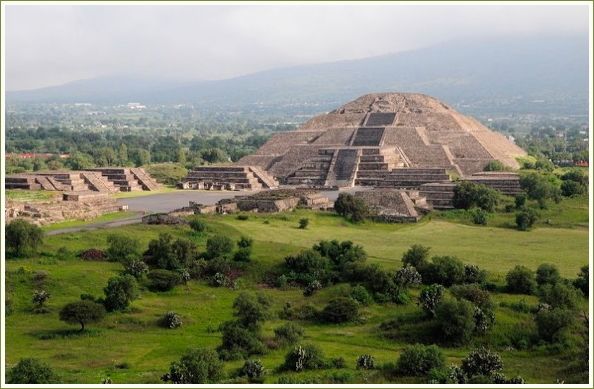
Moon Pyramid at Teotihuacán
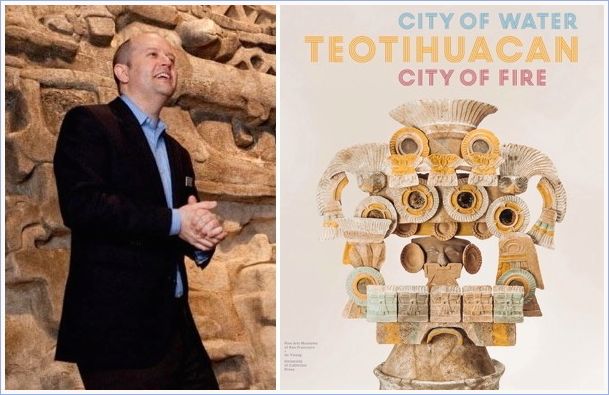
Matthew H. Robb and Catalogue, Teotihuacan: City of Water, City of Fire.
“The catalogue is a representation of an intense collaborative project,” said Matthew. “I was fortunate to be at the de Young for a few years to continue the relationship that had already been established with the Instituto Nacional de Antropología e Historia (INAH) in Mexico for practically thirty years. It goes back to a story about a set of murals from Teotihuacán that were looted in the 1960s and given to the museum in 1976 as a surprise bequest. The de Young worked very diligently over a period of many years to negotiate the legal status of those objects. At the time, that was very unusual and in many respects still is. But they ended up reaching this agreement with INAH where over half of the murals went back to Mexico. That generated this enormous foundation of good will on both sides – which led to the first exhibition in 1983 and many other collaborative projects in the decades that have followed.”

Mural fragment with Storm God impersonator.
Matthew was in the middle of preparing the galleries when we met. Given his time constraints and the limitations of my word-count, the best option was a lesson in how to work the catalogue. But, where to start? “You tell me,” said Matthew.
Being of an age, I have pondered the realm of human sacrifice for some time. It only looks-like I’ve come around. What have we learned about the people who were sacrificed? Were they regarded as disposable? Were they from Teotihuacán or somewhere else?
“We have a lot more data now. There is a group of sacrificial burials associated with the construction of the Pyramid of the Feathered Serpent – around the year 250 or so. We have other burials now from the Pyramid of the Moon as well. One of the really fascinating and challenging things – because of the ways that isotopes leave traces in your bones and teeth – you can now test for where the person grew up. Was it Central Mexico? Did they live all their life in Central Mexico or did they grow up somewhere else and come to Central Mexico? In the case of the burials at the Ciudadela [“the Citadel” a large square courtyard covering 38 acres] it’s a mix. Clearly there are some people who were not too far from Teotihuacán and others who are from farther away. This underscores our sense of Teotihuacán as a multi-ethnic city. We certainly talk about this in the book and demonstrate in the exhibition as well. There is a section of town over on the western edge of Teotihuacán where there are people from Oaxaca. We know that people living there have ties to their presumably Zapotec homeland in Oaxaca. There are people from Michoacán, Vera Cruz, and from the Maya region. We have the objects that show the images from those places are also circulating within the city as well. So, we know that from a pretty early date Teotihuacán is drawing people in from all over Mesoamerica – on some level.”

Mosaic figure, Standing figure, and Eccentrics from Moon Pyramid (200-250).
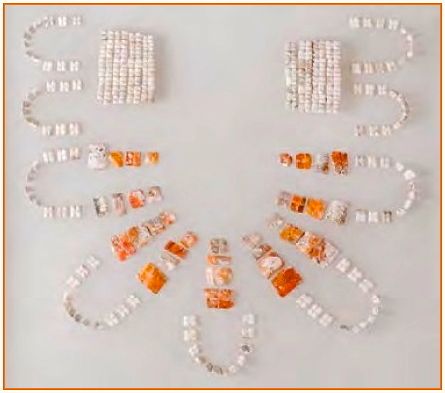
Shell Necklace (200–250), 47.6 x 63.3 x 1cm.
“I think it’s more likely that many of the sacrificial victims that we’re seeing, who were included as part of the dedication of the Pyramid of the Feathered Serpent, were clearly coded as warriors. They have costume elements such as projectile points that suggest they were warriors. They have incredibly bizarre and attractive necklaces made of shells that are carved to look like human teeth. In some cases, a few of the burials included real human jaws as part of the necklace. So, there is a real interest in controlling and manipulating human bodies. What is also challenging about those burials is that in many cases they are young men of prime fighting age. In many cases, they were buried with their hands behind their back. There is an element of coercion going on. But they are buried with valuable things. The necklaces are expensive in terms of the materials, the cost for the time in making them. They are devoting an enormous amount of resources and energy to present these individuals as important subjects.”
Presentation being everything.
“Yes, presentation to the gods and to the community as a whole. There is a high degree of social memory. People would have known and talked about it, remembered it. They are buried around the edges of the pyramid, almost as though they were meant to guard it. (That might be an overreach for some of my colleagues.) But they are clearly meant to go along with the building. It’s not a pattern that we should consider as distinct from the building. It is within the state’s power to control the lives of the people who live in Teotihuacán. There is very much the idea of the transactional nature of sacrifice in a lot of Mesoamerican civilizations. The earth requires feeding. There are benefits that human beings receive from the earth and benefits that human beings must give to the earth. It’s more in that kind of light rather than specifically sacrificing a certain number of people to make a claim about power.”

Figurines (200-250), ceramic and pigments.
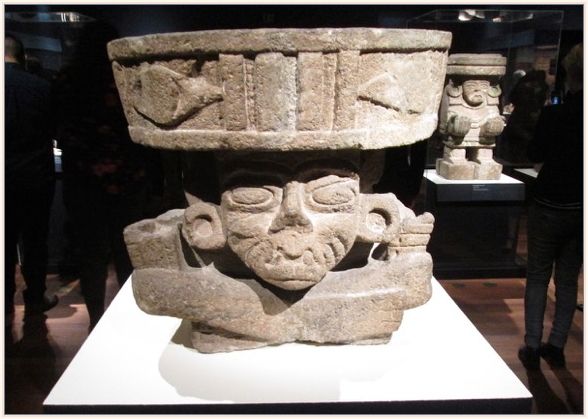
Old Fire God (450-550) and (rear) Chalchiutlicue (250-650).
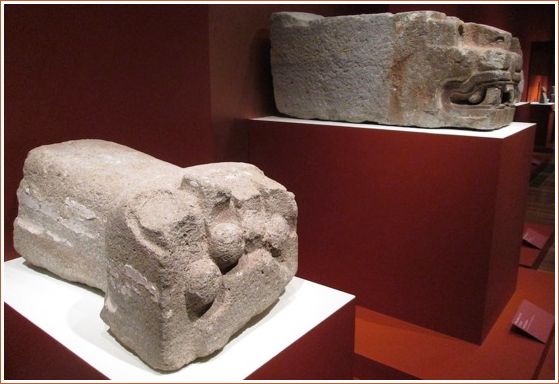
Feline sculpture fragments from the Sun Pyramid – Andesite and pigments. Paw (100-150) and Face (300-400)
[NOTE: Attention cat persons! This exhibition is for you. The skill-sets required for Where’s the Kitty –? The Catalog has a dream Index.]
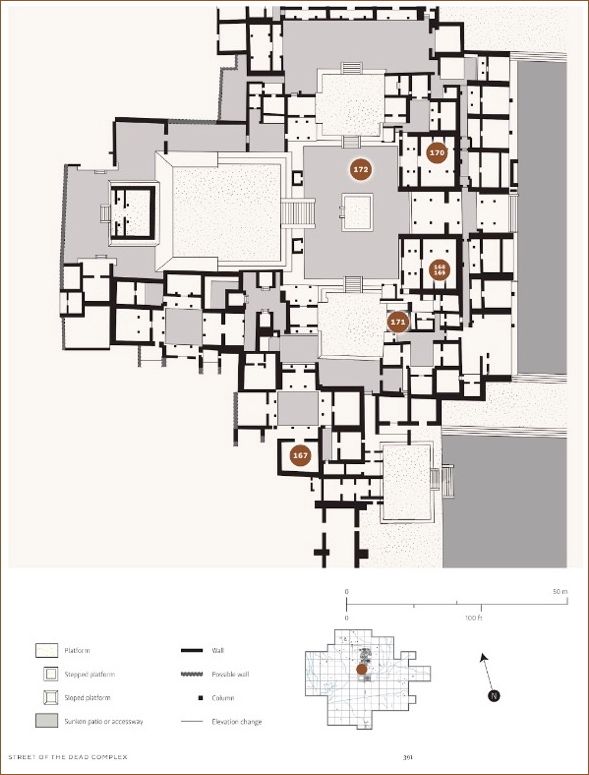
Floor plan, Catalogue, p. 391. Note the location of item #170.
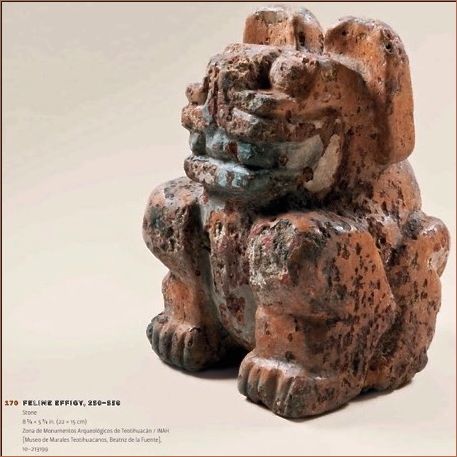
#170–Feline Effigy (250-550), Catalogue, p. 395 (detail).
“We were fortunate to have a very skilled designer on staff, Hillary Olcott, who re-drew all of the maps from the various projects over the years to give the book its design unity. The floor plan for Tetitla [see below] shows an upper middle class walled compound with four discrete entrances. It’s about 60 meters [over 65 yards] by 60 meters – a pretty standard size.”
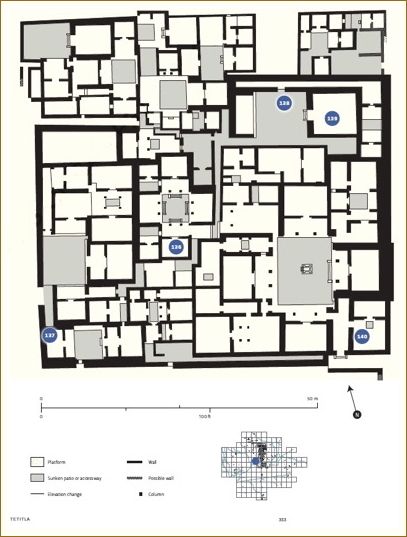
Tetitla floor plan. Catalogue, p. 353

Items 136, 137, 139, 140 – located in Tetitla floor plan above. Catalogue, p. 352.
“We don’t have a good sense of what some of these spaces were for. It’s not immediately apparent what is a sleeping quarter as opposed to a craft-making quarter or a cooking quarter. There is a lot of analysis that has to happen. If you do your archaeology really carefully and you recover the remains of stone carvings, such as little fragments of stone, you could determine that a particular patio was where they carved their tools. A great project of Linda Manzanilla’s – one of the archaeologists who contributed to the book – has been to analyze what was found on the floor. Certain kinds of proteins leave certain kinds of patterns, like those found in a cooking area.”
I understand that leftover proteins from an all-Mesoamerican turkey dinner have been identified. Broken wishbones, drumsticks over the shoulder – has to land somewhere, right?
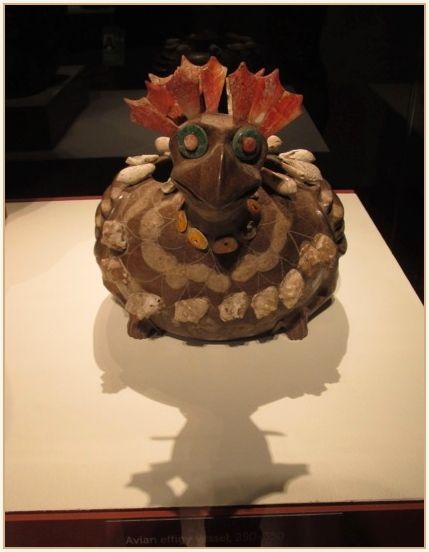
Avian effigy vessel (250-350) – ceramic, shell, greenstone, and stucco.
“In La Ventilla there is evidence where the trash started building up in an alley way. That is taken as a sign that things are falling apart, that the system is starting to break down a little bit. Looking at this floor plan, you get the sense that – if you are over in the upper northeastern corner – it will take you awhile to make your way through and out. Although the floor plan makes everything look nice and tidy, these complexes have a very complicated architectural history – just like today when redesigning a kitchen or converting a garage into an apartment. Teotihuacános did that also. They put in new floors, closed off walls, cut doors through old walls, and sometimes cut right through a mural painting. And we are thinking, ‘But the painting is so important!’ Well, not to that generation. These are active spaces that change over time. Really good archaeology can help us capture some of those changes in a really detailed way.”
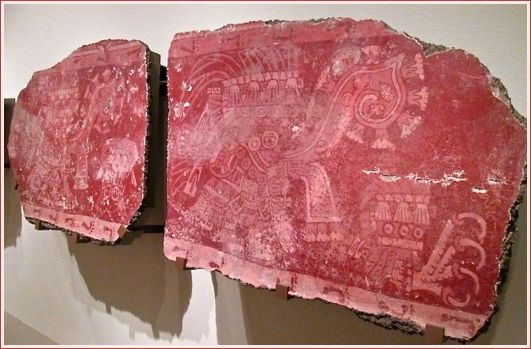
Tassel headdress mural fragments (500-550) – earthen aggregate, stucco and mineral pigments.
What is most fascinating about the whole experience for you?
“It’s the juxtaposition between understanding Teotihuacán as a city – and what you would recognize as a city. Teotihuacán is laid out on a grid. There are people living in apartment buildings with lots of other people who are sort-of related to them. And there are big ceremonial spaces with monumental architecture. So, it’s like any city in that regard. But at the same time, it was a city that operated on a different set of rules than we do. I tend to think about the ways in which we place a big emphasis on things in modern cities, particularly in the US. For instance, we place a great deal of emphasis on speed – we want to get from one place to another quickly. So, all of our infrastructure is devoted to that idea. If you want to get around faster in a car, then you build bigger highways. It’s a governing principle of a city such as San Francisco.”
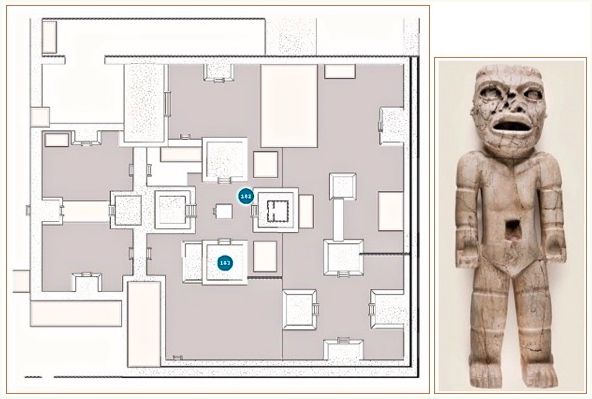
Detail of floor plan at Xalla, p. 415 – with item #183, Standing Figure (500-550).
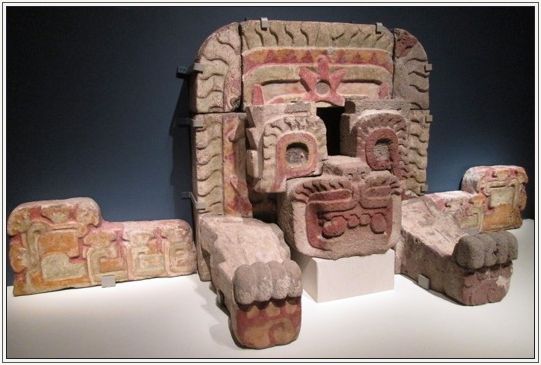
#183 on Floor plan at Xalla. Mosaic jaguar (400) – volcanic stone, stucco, pigments.
“The archaeologists who are excavating this material are trying to put together a system where you understand how it is that a compound like Tlajinga – a relatively low-status compound on the southern edge of the city – has access to what seems to be relatively high-status goods, such as sacred masks and sacred vessels – in comparison to how that system works at a lower social status. And then you see in the center many of the same systems operating. Is it a question of scale? Is it a question of how many things you have? We have all these other issues that come up with the kinds of architecture that people are living in. Some people have access to mural painting in their own domestic spaces, other people do not. Teotihuacán is an enormously complex urban environment and we are only beginning to understand it.”
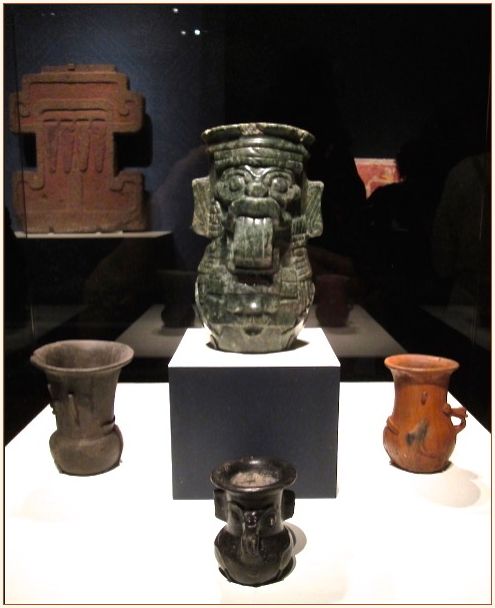
Storm God vessels and Storm God relief in background.
What are the excavators looking for today?
“We’re still looking for evidence about how the city functioned on a social and governmental level. One of the things that we can now say – as a result of projects over the last ten to twenty years – and in contrast to what we know about the Maya and other ancient civilizations – is that when the Teotihuacános are building these pyramids they are not dedicating them to specific rulers. At least as far as we can tell. The evidence is very, very different. For example, we’re not finding a single body laid out with all kinds of vessels and sacrificial retainers. What we are finding are these very complex statements about materials, about animals and human beings – and combining them in a way that held deep symbolic resonance for Teotihuacános. In some cases, we’re still in the process of interpreting. The pyramids are not about individual rulers, but potentially some other more collective vision about the way the world is supposed to look.”
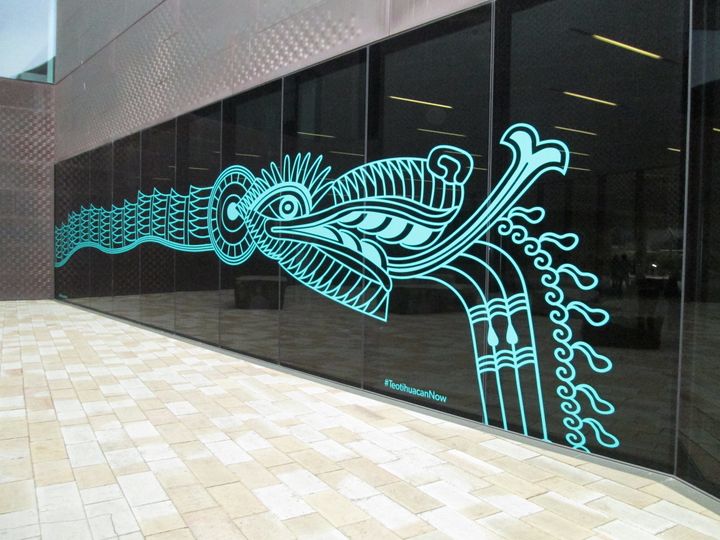
Courtyard entrance to the de Young Museum.